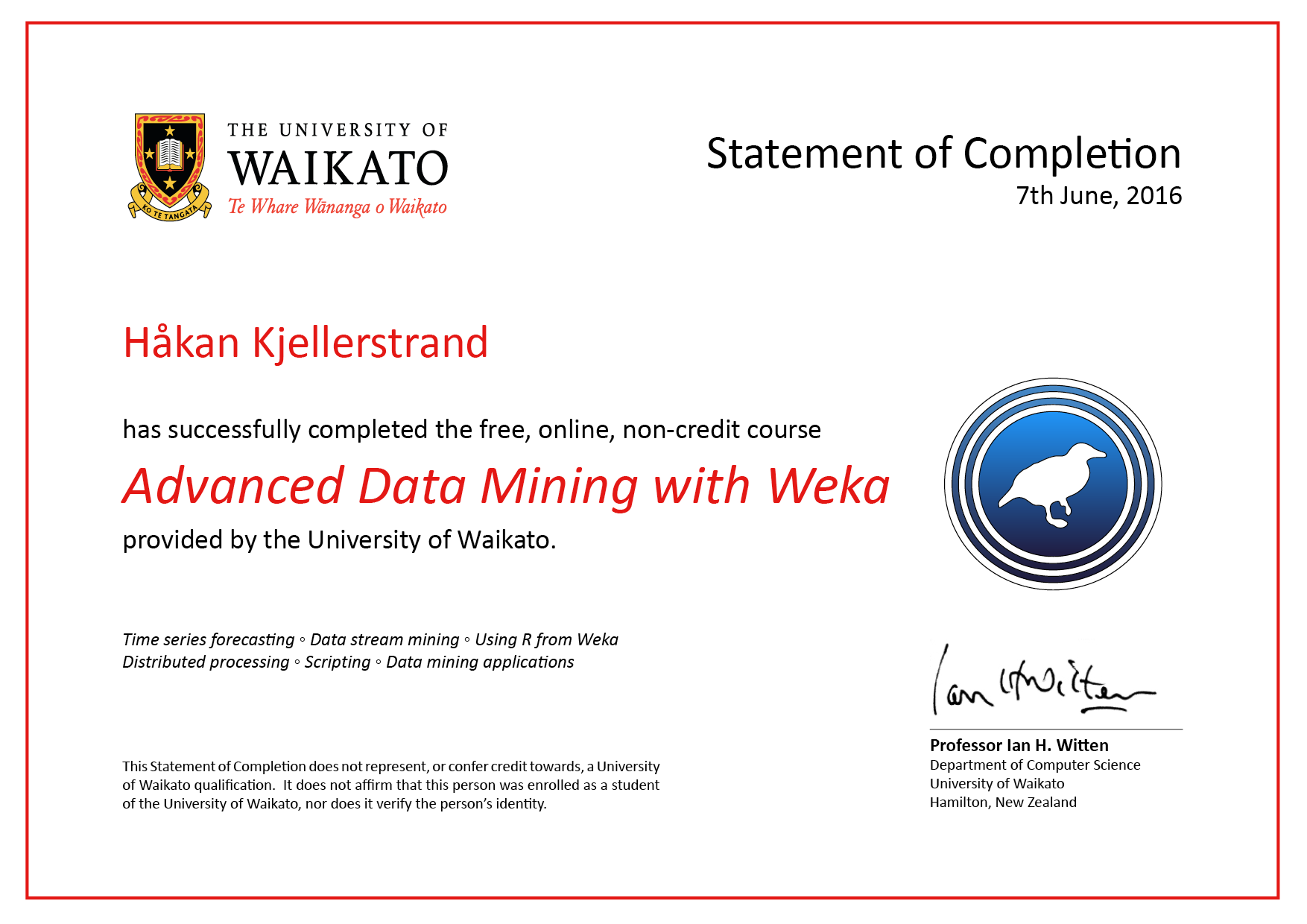My Weka page
Here are some small programs purporting to show the versatility of the Weka data mining/machine learning system and what it can do. I will not explain everything (in fact, I will not explain very much at all). At the Weka site http://www.cs.waikato.ac.nz/~ml/weka/index.html you can read more about the system as well as downloading it.Also see:
Weka MOOC's: All the MOOC videos are on YouTube: .
As Weka (Explorer) is a Java standalone application with a very nice GUI and a lot more to tweak than these applets indicates, you will definitely enjoy Weka more if you use the whole package of your own.
The programs (so far...)
Please note: these programs was written 2002/2003 for older versions of Weka (and mostly as a "concept of proof" how to "appletize" Weka), and has later been fixed for working with the current Weka version 3.5.2 (mostly correcting the classnames for the classifiers). These programs was compiled using Sun Java compiler version 1.5 and Weka version 3.5.2.- Simple Weka Applet 1
Here you can see some of the algorithms in the works, as well as using different data sets (and providing one of your own in ARFF data format) .
Source files: WekaApplet1.java, Weka1.java
- Weka J48 Applet
Applet using (some of) the options of the J48 algorithm.
Source files: WekaJ48Applet.java, WekaJ48.java
- Simple text classification (information)
Very simple text classification applets: Source files: TextClassifierApplet.java, TextClassifier.java
- Very simple Association Rules (Apriori) applets: Source files: AssociationRulesApplet.java, AssociationRules.java
- Copy the file ExpandFreqField.java to the Weka directory
weka/filters/unsupervised/instance - Add the following line in the file
weka/gui/GenericObjectEditor.propstogether with other filters.unsupervised.instance filters:
weka.filters.unsupervised.instance.ExpandFreqField,\
(don't forget the trailing "\"). - Compile the Java file
- Start Weka Explorer
Some of my other pages about Weka
Also see the following pages on my site mentioning Weka.- If you can read Swedish (or are courageous) you may see my data mining presentation pages, where some of the basic principles and algorithms of machine learning and data mining are explained.
- The badge problem which is an analysis of a (recreational) data set, using Weka.
- My Data Mining, Machine Learning etc page.
ARFF data files
The data file normally used by Weka is in ARFF file format, which consist of special tags to indicate different things in the data file (mostly: attribute names, attribute types, attribute values and the data).Here is a list of some ARFF-file you can use, many are standard data sets often used in the machine learning community. Most of them are available from the Weka site. Many of them are also described and downloadable from http://www.ics.uci.edu/~mlearn/MLRepository.html.
If you click on the link in the list below you can see for yourself what the data set looks like. Please note that some files are quite big, and for some algorithms it will take a lot of time (often a lot of time!). The number in parenthesis is the size in bytes. In some of the files there are quite good comments for the data set, other has no explanation at all (they are probably converted from some other source by myself).
One more thing: The class attribute (i.e. the attribute we want to learn) must be the last.
- http://www.hakank.org/weka/zoo2_x.arff (6296)
- http://www.hakank.org/weka/golf.arff (383)
- http://www.hakank.org/weka/cpu.arff (6936)
- http://www.hakank.org/weka/sunburn.arff (573)
- http://www.hakank.org/weka/wine.arff (13790)
- http://www.hakank.org/weka/iris_discretized.arff (12390)
- http://www.hakank.org/weka/shape.arff (296)
- http://www.hakank.org/weka/titanic.arff (42322)
- http://www.hakank.org/weka/disease.arff (457)
- http://www.hakank.org/weka/labor_discretized.arff (9595)
- http://www.hakank.org/weka/zoo.arff (9408)
- http://www.hakank.org/weka/monk3.arff (1944)
- http://www.hakank.org/weka/monk2.arff (2602)
- http://www.hakank.org/weka/monk1.arff (1972)
- http://www.hakank.org/weka/credit.arff (23254)
- http://www.hakank.org/weka/contact-lenses.arff (2890)
- http://www.hakank.org/weka/iris.arff (7486)
- http://www.hakank.org/weka/labor.arff (8255)
- http://www.hakank.org/weka/weather.arff (489)
- http://www.hakank.org/weka/weather.nominal.arff (587)
- http://www.hakank.org/weka/BC.arff (25063)
- http://www.hakank.org/weka/G2.arff (8125)
- http://www.hakank.org/weka/GL.arff (10504)
- http://www.hakank.org/weka/HD.arff (22564)
- http://www.hakank.org/weka/HE.arff (8639)
- http://www.hakank.org/weka/HO.arff (29907)
- http://www.hakank.org/weka/IR.arff (4919)
- http://www.hakank.org/weka/LA.arff (4817)
- http://www.hakank.org/weka/LY.arff (11150)
- http://www.hakank.org/weka/SO.arff (8068)
- http://www.hakank.org/weka/V1.arff (31252)
- http://www.hakank.org/weka/VO.arff (33016)
- http://www.hakank.org/weka/auto93.arff (13617)
- http://www.hakank.org/weka/tic-tac-toe.arff (26569)
- http://www.hakank.org/weka/prnn_virus3.arff (6657) From Pattern Recognition and Neural Networks' by B.D. Ripley
- http://www.hakank.org/weka/prnn_viruses.arff (7672) From Pattern Recognition and Neural Networks' by B.D. Ripley
- http://www.hakank.org/weka/tic-tac-toe.arff (26569)
- http://www.hakank.org/weka/badges_plain.arff (11262) (see my analysis of this data set here)
- http://www.hakank.org/weka/badges2.arff (21295) (see my analysis of this data set here)
- http://www.hakank.org/weka/spambase.arff (700661)
- http://www.hakank.org/weka/spambase_real.arff (700659)
- http://www.hakank.org/weka/ticdata_categ.arff (1012920) (Caravan data)
- http://www.hakank.org/weka/exper1.arff (106047)
- http://www.hakank.org/weka/soybean.arff (202935)
- http://www.hakank.org/weka/CH.arff (483568)
- http://www.hakank.org/weka/HY.arff (336201)
- http://www.hakank.org/weka/MU.arff (743765)
- http://www.hakank.org/weka/SE.arff (337512)
- http://www.hakank.org/weka/kropt.arff (532550)
ARFF versions of DASL data
DASL - The Data and Story Library is a great collection of data sets, with background stories and some analysis. For ARFF versions of these data sets, see ARFF versions of DASL data sets.Related pages:
- My Eureqa page: Eureqa is a great tool for symbolic regression
- My JGAP page, I have written my own symbolic regression program using JGAP (Java)
Back to my homepage
Created by Hakan Kjellerstrand hakank@gmail.com
